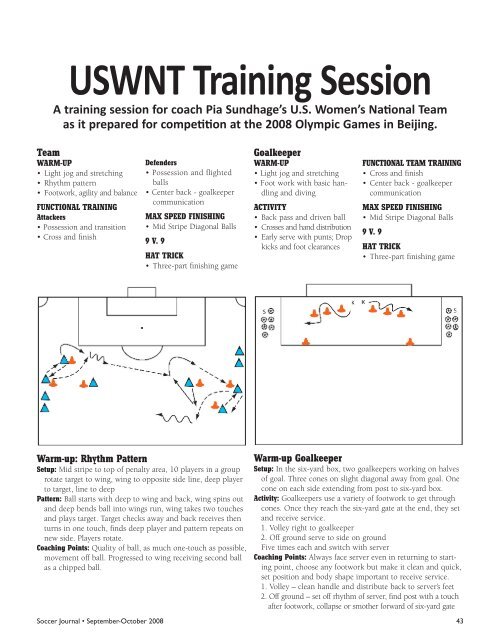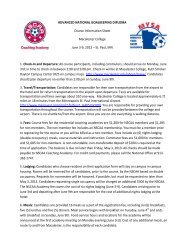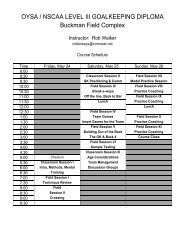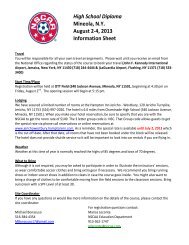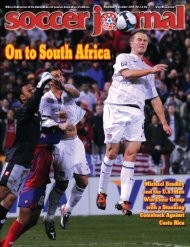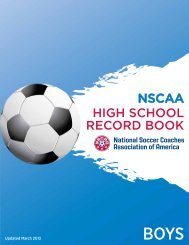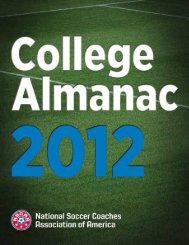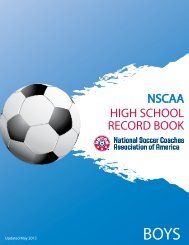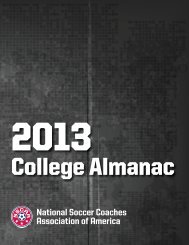USWNT Training Session - National Soccer Coaches Association of ...
USWNT Training Session - National Soccer Coaches Association of ...
USWNT Training Session - National Soccer Coaches Association of ...
Create successful ePaper yourself
Turn your PDF publications into a flip-book with our unique Google optimized e-Paper software.
<strong>USWNT</strong> <strong>Training</strong> <strong>Session</strong><br />
A training session for coach Pia Sundhage’s U.S. Women’s <strong>National</strong> Team<br />
as it prepared for competition at the 2008 Olympic Games in Beijing.<br />
Team<br />
Warm-Up<br />
• Light jog and stretching<br />
• Rhythm pattern<br />
• Footwork, agility and balance<br />
Functional <strong>Training</strong><br />
Attackers<br />
• Possession and transition<br />
• Cross and finish<br />
Defenders<br />
• Possession and flighted<br />
balls<br />
• Center back - goalkeeper<br />
communication<br />
Max Speed Finishing<br />
• Mid Stripe Diagonal Balls<br />
9 v. 9<br />
Hat Trick<br />
• Three-part finishing game<br />
Goalkeeper<br />
Warm-up<br />
• Light jog and stretching<br />
• Foot work with basic handling<br />
and diving<br />
Activity<br />
• Back pass and driven ball<br />
• Crosses and hand distribution<br />
• Early serve with punts; Drop<br />
kicks and foot clearances<br />
Functional Team <strong>Training</strong><br />
• Cross and finish<br />
• Center back - goalkeeper<br />
communication<br />
Max Speed Finishing<br />
• Mid Stripe Diagonal Balls<br />
9 v. 9<br />
HAT TRICK<br />
• Three-part finishing game<br />
Warm-up: Rhythm Pattern<br />
Setup: Mid stripe to top <strong>of</strong> penalty area, 10 players in a group<br />
rotate target to wing, wing to opposite side line, deep player<br />
to target, line to deep<br />
Pattern: Ball starts with deep to wing and back, wing spins out<br />
and deep bends ball into wings run, wing takes two touches<br />
and plays target. Target checks away and back receives then<br />
turns in one touch, finds deep player and pattern repeats on<br />
new side. Players rotate.<br />
Coaching Points: Quality <strong>of</strong> ball, as much one-touch as possible,<br />
movement <strong>of</strong>f ball. Progressed to wing receiving second ball<br />
as a chipped ball.<br />
Warm-up Goalkeeper<br />
Setup: In the six-yard box, two goalkeepers working on halves<br />
<strong>of</strong> goal. Three cones on slight diagonal away from goal. One<br />
cone on each side extending from post to six-yard box.<br />
Activity: Goalkeepers use a variety <strong>of</strong> footwork to get through<br />
cones. Once they reach the six-yard gate at the end, they set<br />
and receive service.<br />
1. Volley right to goalkeeper<br />
2. Off ground serve to side on ground<br />
Five times each and switch with server<br />
Coaching Points: Always face server even in returning to starting<br />
point, choose any footwork but make it clean and quick,<br />
set position and body shape important to receive service.<br />
1. Volley – clean handle and distribute back to server’s feet<br />
2. Off ground – set <strong>of</strong>f rhythm <strong>of</strong> server, find post with a touch<br />
after footwork, collapse or smother forward <strong>of</strong> six-yard gate<br />
<strong>Soccer</strong> Journal • September-October 2008 43
Team Agility and Flexibility<br />
Setup: Two agility ladders with five-yard explosion <strong>of</strong>f end <strong>of</strong><br />
ladders.<br />
Activity: Team goes through 10 different footwork ladder patterns.<br />
Then through 20 yards <strong>of</strong> lunge stretching.<br />
Coaching Points: Fast feet and head up. Drop hips, drive knee<br />
and explode five yards <strong>of</strong>f ladder.<br />
Goalkeeper Activity<br />
Setup: A server with balls on each flank and a target forward<br />
for opposition.<br />
Activity: Goalkeeper sets up to receive a flighted ball into the<br />
box, then distributes that ball to the opposite server. Five<br />
each side.<br />
Coaching Points: Be patient. Collect ball at its highest point.<br />
“Keeper” call or “Away” call. If away, track the ball until it’s<br />
out <strong>of</strong> play. On distribution follow through to target.<br />
Functional <strong>Training</strong>: Attackers<br />
Setup: 30 x 25 yd grid divided into three equal zones (10 X 25).<br />
Six green, two red and two yellow. Greens are divided, three in<br />
each end zone. One red and one yellow defend opposite against<br />
each green team. Remaining yellow and red are in middle zone.<br />
Activity: Three greens possess in their zone, trying to achieve four<br />
passes. At four they will play the target in the middle, who has<br />
one touch to find a green from the same grid transitioning toward<br />
the other grid. The green transitioning plays the ball into<br />
the opposite green zone and joins to play 4 v. 1. Target in middle<br />
should alternate between receiver and pressure. To avoid the<br />
defenders tiring too quickly, they should occasionally change<br />
with the target in the same color. If the defender wins the ball,<br />
they will play the target while the team they won it from transitions<br />
to join the middle to then join the opposite team.<br />
Goalkeeper Activity<br />
Setup: In the six-yard box a cone is placed six yards from each<br />
post. A second cone is placed 20 yards from each post. Two<br />
servers are positioned with balls one on the side and one<br />
midway 20 yards out.<br />
Activity: Goalkeeper receives a ball to feet from server on side<br />
and plays the ball back to server with feet. Goalkeeper then<br />
finds ball line and moves toward the server 20 yards out.<br />
Reading the rhythm <strong>of</strong> the server to go to set, the goalkeeper<br />
saves a low driven ball at the goalkeeper. Five reps <strong>of</strong> each.<br />
Coaching Points: Back pass – Read the pace <strong>of</strong> the ball and take<br />
two touches when fast and one when slow. Accuracy to the<br />
target is important. On a low driven shot, quickly find the<br />
ball line, better to set early than late and make the save going<br />
forward to increase deflection angle.<br />
44 <strong>Soccer</strong> Journal • September-October 2008
Functional <strong>Training</strong>: Defender<br />
Setup: 15 x 15 box on the midline and a 15 x 15 box at the 18.<br />
Three teams <strong>of</strong> four in three different colors. 4 v. 2 in each<br />
box, three four-minute rounds.<br />
Activity: Teams play 4 v. 2 trying for four passes. After the<br />
fourth pass, play a flighted ball into the other grid. The defenders<br />
in the new grid have to stay on the line closest to<br />
the old box until the ball passes over them. The new grid<br />
plays 4 v. 2 and repeat the service after the fourth pass. This<br />
is played for a time limit with each team trying to accrue a<br />
point for four passes followed by an accurate service. If the<br />
defenders win the ball, they keep it until the four can regain<br />
it. If it’s played out the coaches start a ball to the four. After<br />
the time the defenders move into a space to become attackers<br />
and the team in the space splits and sends two to each <strong>of</strong><br />
the grids as defenders.<br />
Goalkeeper Activity<br />
Setup: One goalkeeper in goal, a server 35 yards out on the<br />
width, a target wide over the midline, a coach at the top <strong>of</strong><br />
the penalty area.<br />
Activity: Goalkeeper receives a flighted ball served as an early<br />
ball behind a back line <strong>of</strong> defenders. She punts/drop kicks<br />
this ball to target. Server plays a driven ball to the coach,<br />
who knocks it down into box for goalkeeper to two-touch<br />
clear to target.<br />
Coaching Points: Early service – read pace and spin on ball, collect<br />
before it bounces, last step to drive though ball, keeper<br />
call, focus to hit target on quick counter. Knocked down ball<br />
– Read through ball, take a touch forward and wide <strong>of</strong> goal,<br />
find target on over midfield.<br />
Functional – Attackers<br />
Setup: Three central players and two wide players, a goalkeeper<br />
in goal.<br />
Activity: From a central position a ball is played with pace out<br />
wide. The wide player receives it and either takes it to the end<br />
line to serve or serves it early. The forwards time their runs to<br />
get an attempt on goal. Alternate balls to wide players.<br />
Coaching Points: The quality <strong>of</strong> the service is critical. It must<br />
have pace and be delivered to an area the goalkeeper can’t<br />
intercept. Timing <strong>of</strong> the forward’s run is important to attack<br />
the ball for a goal scoring chance. When attacking the ball<br />
bend the run so that the body is square to the oncoming<br />
service.<br />
<strong>Soccer</strong> Journal • September-October 2008 45
NSCAA photo by Craig Bohnert<br />
Functional – Defenders<br />
Setup: Several central players, two wide players, two defenders,<br />
GK in goal.<br />
Activity:<br />
1. Ball gets played to a central player who takes a long-range<br />
shot, then recovers.<br />
2. Ball is played from the same wide player to a central player<br />
who switches field to the other wing. The wing either goes<br />
end line or serves early. The one shooter plus an additional<br />
attacker time their run to meet the service for a scoring<br />
chance. The two defenders organize to negate the chance.<br />
Coaching Points: This is designed to help the communication between<br />
the goalkeeper and the two center backs. Once the ball has<br />
switched, the two center backs drop to accomplish two things:<br />
1. Shorten the window <strong>of</strong> space to attack behind the defenders<br />
and before the goalkeeper.<br />
2. Once the ball is served they can attack the service going forward<br />
instead <strong>of</strong> being <strong>of</strong>f balance and running at their on goal.<br />
Midline Five-Second Maximum Speed<br />
Setup: Four lines at the midline, two facing toward each goal.<br />
Goalkeepers in goals. Loads <strong>of</strong> balls. Each player gets five<br />
times as receiver.<br />
Activity: Interior line takes a touch, which releases receiving<br />
line. On second touch a diagonal ball is flighted for the receiver<br />
to bring to ground and strike on goal with the second<br />
touch. Server and receiver switch lines.<br />
Coaching Points: The idea is that the receiver has five seconds<br />
to reach maximum speed. They must decelerate to receive<br />
and strike on goal.<br />
Coach Pia Sundhage provided service<br />
during a shooting drill as the U.S. team<br />
prepared for its semifinal match against Japan<br />
at the 2008 Beijing Olympic Games.<br />
46 <strong>Soccer</strong> Journal • September-October 2008
9 v. 9 (left)<br />
Setup: Field size top <strong>of</strong> penalty area to end line. Eight field<br />
players, one goalkeeper per team.<br />
Activity: Regular soccer rules 9 v. 9<br />
Coaching Points: Emphasis on<br />
1. Playing forward and joining<br />
2. Speed <strong>of</strong> play<br />
3. Creating quality chances in final 1/3<br />
Note: Sundhage was very positive, only stopping play to point out<br />
excellence.<br />
The U.S. Women’s Olympic Team jogged before a training session at<br />
the U.S. Olympic Committee’s High Performance Center at Beijing<br />
Normal University on Aug. 17 before the 4-2 semifinal victory against<br />
Japan that put them into the gold medal match against Brazil.<br />
Hat Trick (above)<br />
• Player 1 takes a touch and shoots before the ball crosses top <strong>of</strong> box.<br />
• Player 1 then turns to receive ball from Player 2 and lays ball<br />
<strong>of</strong>f to player 2 to strike outside <strong>of</strong> the top <strong>of</strong> the box.<br />
• Player 3 takes a touch on the outside and serves a flighted<br />
ball for Players 1 and 2 making runs into the box. The ball<br />
must be finished out <strong>of</strong> the air (volley or header.)<br />
• All three shots have to score to accomplish the hat trick.<br />
Note: The U.S. team has never accomplished the Hat Trick – the<br />
goalkeepers always win!<br />
NSCAA photo by Craig Bohnert<br />
<strong>Soccer</strong> Journal • September-October 2008 47


